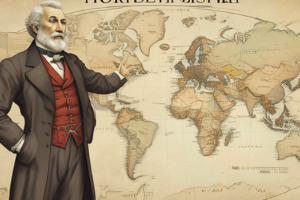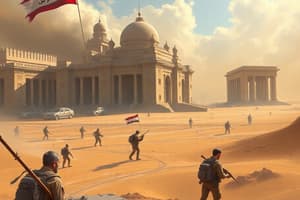Podcast
Questions and Answers
What was a significant outcome of the new constitution enacted in 1917?
What was a significant outcome of the new constitution enacted in 1917?
- It established a monarchy.
- It implemented democratic reforms that improved worker rights. (correct)
- It restricted the voting rights of the middle class.
- It led to an increase in foreign military presence.
Which product was Brazil primarily known for exporting in 1870?
Which product was Brazil primarily known for exporting in 1870?
- Beef
- Coffee (correct)
- Bananas
- Wheat
What was one of the major weaknesses in Latin America's political systems during the early 1900s?
What was one of the major weaknesses in Latin America's political systems during the early 1900s?
- Governments were excessively decentralized.
- Democratic processes were overly inclusive.
- The lower and middle classes had no real influence over governance. (correct)
- There was a lack of foreign investment in natural resources.
What impact did industrialization have on employment in Latin America?
What impact did industrialization have on employment in Latin America?
What role did foreign investors play in the Latin American economy during the early 20th century?
What role did foreign investors play in the Latin American economy during the early 20th century?
What was the primary reason for the United States' intervention in Panama's separation from Colombia?
What was the primary reason for the United States' intervention in Panama's separation from Colombia?
How did President Theodore Roosevelt justify U.S. intervention in Latin American affairs?
How did President Theodore Roosevelt justify U.S. intervention in Latin American affairs?
What was the main consequence of the 'Dollar Diplomacy' policy?
What was the main consequence of the 'Dollar Diplomacy' policy?
Which factor contributed to the political unrest in Mexico during the late 19th and early 20th centuries?
Which factor contributed to the political unrest in Mexico during the late 19th and early 20th centuries?
What was Emiliano Zapata's primary goal during the Mexican Revolution?
What was Emiliano Zapata's primary goal during the Mexican Revolution?
How did Francisco Madero's presidency contribute to the continuation of the Mexican Revolution?
How did Francisco Madero's presidency contribute to the continuation of the Mexican Revolution?
What event triggered the Spanish-American War?
What event triggered the Spanish-American War?
What was the primary consequence of the Spanish-American War for the United States?
What was the primary consequence of the Spanish-American War for the United States?
Flashcards
1917 Reforms
1917 Reforms
Political reforms in 1917 that established a democratic framework, improving stability and workers' rights.
Latin America's Exports
Latin America's Exports
Products like coffee, beef, and bananas were exported, impacting international trade.
Industrialization in Latin America
Industrialization in Latin America
The growth of factories and professions beginning in the 1900s, leading to urban development.
Middle Class Concerns
Middle Class Concerns
Signup and view all the flashcards
Power Dynamics
Power Dynamics
Signup and view all the flashcards
Spanish-American War
Spanish-American War
Signup and view all the flashcards
American Protectorate
American Protectorate
Signup and view all the flashcards
Panama Canal
Panama Canal
Signup and view all the flashcards
Dollar Diplomacy
Dollar Diplomacy
Signup and view all the flashcards
Porfirio Díaz
Porfirio Díaz
Signup and view all the flashcards
Francisco Madero
Francisco Madero
Signup and view all the flashcards
Emiliano Zapata
Emiliano Zapata
Signup and view all the flashcards
Mexican Revolution
Mexican Revolution
Signup and view all the flashcards
Study Notes
US Intervention in Latin America
- US intervention in Latin American affairs began in the late 1800s
- Conflicts with Spain over Cuba led to a war, transforming Cuba into an American protectorate
- Puerto Rico was also taken over by the US
- In 1903, Panama separated from Colombia with US support, gaining a strip of land for the Panama Canal
- US President Roosevelt halted European intervention in Latin America in 1914
- Roosevelt asserted US responsibility for handling Latin American misconduct
Dollar Diplomacy
- US investments in Latin America increased, leading to a rise in American power and influence
- Financial resources were utilized, and European financial intervention decreased
- US troops were sent to several Latin American countries, including Cuba and Mexico
Political Influence in Latin America
- Landowners in 1870s held significant political power
- They often favoured dictators who supported their interests
- Political power was concentrated in the hands of a small elite, limiting voting rights
The Porfirio Diaz Era in Mexico
- Mexico was ruled by Porfirio Diaz from 1877 to 1911
- Diaz supported a centralized government, benefiting landowners and foreign capitalists
- The Diaz era saw widespread suffering from low wages and land inequality, leading to unrest
The Mexican Revolution
- Dissatisfaction with Diaz's rule led to revolution
- Francisco Madero, a liberal landowner, became president after Diaz was overthrown
- Madero's attempts to control the revolution failed
- Emiliano Zapata led a revolutionary movement demanding land redistribution and agricultural improvements
- Zapata's movement could not be stopped
Economic and Industrial Development
- Latin American countries began industrializing in the early 1900s
- Increased production of goods like coffee, beef, and wheat
- Dependence on Western nations persisted in terms of investments
- Middle and working class professions increased in number
- More people were able to participate in politics due to suffrage
Economic Strengths and Weaknesses
- Latin American economies were stable and growing
- Increased natural resources and cash crops were exported
- However, lower and middle classes had little power
- Foreign investors controlled natural resources
Studying That Suits You
Use AI to generate personalized quizzes and flashcards to suit your learning preferences.




